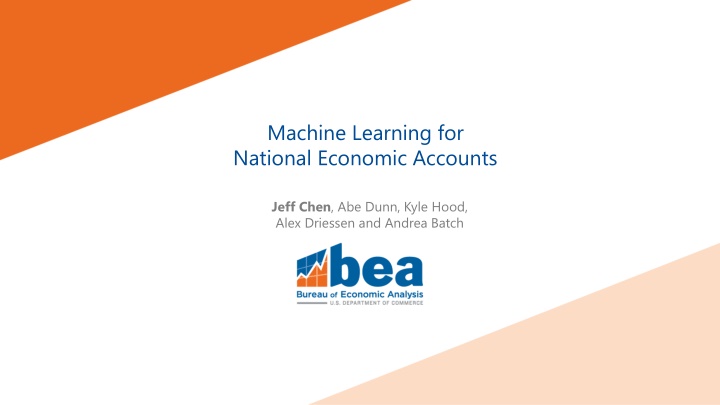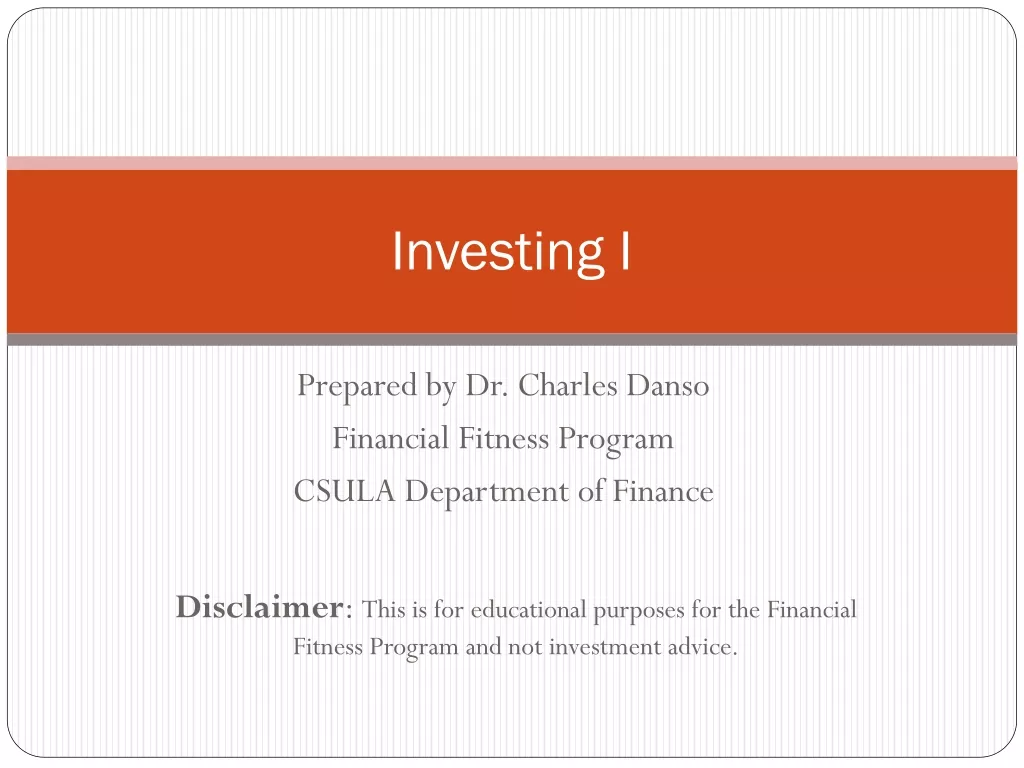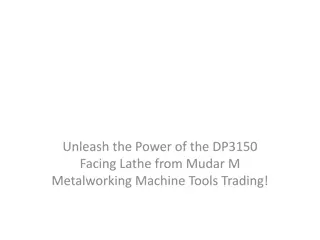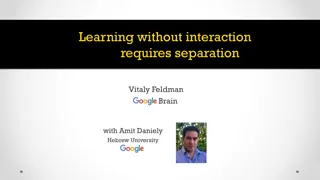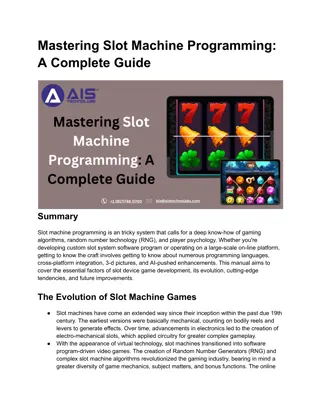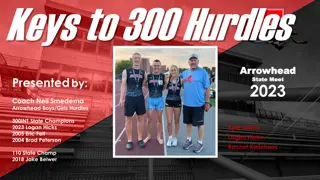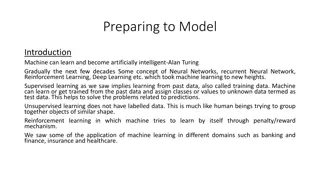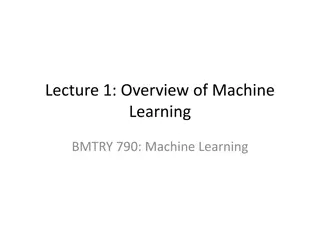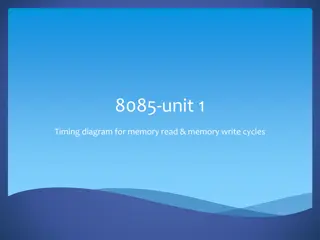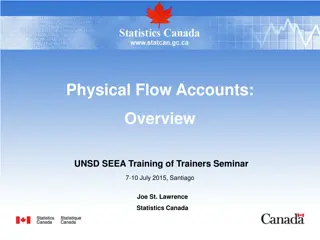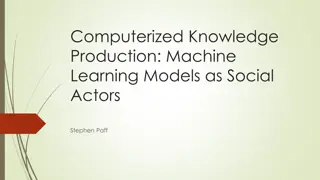Machine Learning for National Economic Accounts: Possibilities and Hurdles
Exploring the application of machine learning in national economic accounts presents promising opportunities and challenges. The potential of ML to enhance accuracy in estimating components like PCE services and predicting economic growth is discussed. However, hurdles such as handling a large number of variables, small sample sizes, and the need to surpass current methods are also highlighted. Strategies for selecting variables efficiently, addressing small samples, and evaluating model performance are crucial in leveraging ML effectively within national economic accounts.
Download Presentation

Please find below an Image/Link to download the presentation.
The content on the website is provided AS IS for your information and personal use only. It may not be sold, licensed, or shared on other websites without obtaining consent from the author.If you encounter any issues during the download, it is possible that the publisher has removed the file from their server.
You are allowed to download the files provided on this website for personal or commercial use, subject to the condition that they are used lawfully. All files are the property of their respective owners.
The content on the website is provided AS IS for your information and personal use only. It may not be sold, licensed, or shared on other websites without obtaining consent from the author.
E N D
Presentation Transcript
Machine Learning for National Economic Accounts Jeff Chen, Abe Dunn, Kyle Hood, Alex Driessen and Andrea Batch
Motivation Second Estimate End of Quarter Advance Estimate When we d like it to be available When source data are available 2
Motivation Second Estimate End of Quarter Advance Estimate Short-term prediction using machine learning (for services sector estimates) Alternative Data Traditional Data 3
Possibilities: ML for National Economic Accounts Identify which modeling considerations (e.g. algorithm, data, feature selection) are associated with accuracy gains by PCE services component. 2 1 3 Construct hurricane tracks for projected quarterly economic growth to help build consensus that a predicted growth is likely. Develop a simple framework for evaluating tradeoffs in terms of revision reductions relative to current methods. M1vs. M2 4
Hurdles: There are more variables than records. Issue Solution Traditional statistical methods have trouble with k > n Many ML methods can efficiently sift through inputs that maximize predictive accuracy. Id Y X1 X2 X3 X4 X5 . . . x999 Id Y X1 X2 X3 X4 X5 . . . x999 1 1 2 2 3 3 . . . . 29 29 3 1 2 Ranked Which variables to choose?! 5
Hurdles: Small samples call for different strategies. Issue Solution For national accounts, the ideal is to find a general set of approaches that will consistently yield accuracy gains. Typical goal of prediction is to crown a definitive winner among all tested models. M2 M1 M1 M2 Algorithm 2 Algorithm 3 Algorithm 1 0 0 RMSE RMSE (While M1 is better than M2, in small samples there is effectively no difference) (If M1 and M2 are derived from the same algorithm but with different inputs, we can form a strategy around a class of algorithm) 6
Hurdles: Predictions must beat current methods. Absolute accuracy of a model is important, but it needs to be contextualized in terms of national economic accounts. HOME GUEST 7
Approach (Part 1): A Prediction Horse Race Evaluate Absolute Performance Identify Best Relative Reductions Prediction Horse Race ???= ??[????,??,? ?, 1 2 3 Predict the Quarterly Services Survey (QSS). 8
Step 1: A Prediction Horse Race ???= ??[????,??,? ? Predict quarterly industry growth ??? using a large number of combinations of algorithms, data, and variable selection methods 9
Step 1: Data inHorse Race Draw on a broad range of potential source data to compare traditional sources and alternative sources. ???= ??[????,??,? ? Quarterly Services Survey U.S. Census Bureau Credit Card Transactions First Data Palantir/ Fed Board Revised Series 192 industries Lagged QSS U.S. Census Bureau 188 industry codes lagged for t-4 to t-1 Search Queries Google Trends 230 associated searches 188 industry series n = 31 quarters Source data for significant proportion of PCE Services Current Employment Survey BLS 140 industries Consumer Price Index BLS 600+ indexes 10 10/4/2024
Step 1: Variable Selection Procedures inHorse Race ???= ??[????,??,? ? Cherry Picking Include only conceptually similar variables. Kitchen Sink All-in. 25 data set combinations 11 10/4/2024
Step 1: Algorithms inHorse Race ???= ??[????,??,? ? Extreme Gradient Boosting 4Q Moving Average Ridge Regression Support Vector Machines Stepwise Regression CART Multi-Adaptive Regression Splines LASSO Regression Random Forest 12 10/4/2024
Step 1: Algorithms inHorse Race ???= ??[????,??,? ? Extreme Gradient Boosting 4Q Moving Average Ridge Regression Type of Method Univariate Multivariate Regression Non-Linear or Non-Parametric Support Vector Machines Stepwise Regression CART Multi-Adaptive Regression Splines LASSO Regression Random Forest 13 10/4/2024
Step 1: Algorithms inHorse Race ???= ??[????,??,? ? Extreme Gradient Boosting 4Q Moving Average Ridge Regression Interpretation Linear Interpretation Other Interpretation None Support Vector Machines Stepwise Regression CART Multi-Adaptive Regression Splines LASSO Regression Random Forest 14 10/4/2024
Step 1: Algorithms inHorse Race ???= ??[????,??,? ? Extreme Gradient Boosting 4Q Moving Average Ridge Regression Single or Ensemble (many in one) Single Ensemble Support Vector Machines Stepwise Regression CART Multi-Adaptive Regression Splines LASSO Regression Random Forest 15 10/4/2024
Methods: A Prediction Horse Race Test Train For Later Iterations 1 For Later Iterations Test Train 2 Iteration 3 4 5 6 7 t-5 t-4 t-3 t-2 t-1 t t+1 t+2 t+3 t+4 t+5 Time 16
Methods: A Prediction Horse Race 886,608 models were trained, based on the combinations of industry x data sets x algorithm x variable selection x time period 17
Prediction tracks show how persistent a growth pattern is considering many different modeling scenarios. 18 10/4/2024
Some algorithms are more flexible in accounting for different ways of integrating information. NAICS 6211: Physician Offices 19 10/4/2024
Approach (Part 2): A Prediction Horse Race Evaluate Absolute Performance Identify Best Relative Reductions Prediction Horse Race ???= ??[????,??,? ?, 1 2 3 Measure what generally leads to an accuracy increase in the QSS 20
Step 2: Average Absolute Accuracy ?????,?,? = ? + ??+ ??+ ??+ ??,?,? Estimate a fixed-effects regression to parse out the average accuracy gain associated with each algorithm, data set, etc. 21
Results: Average RMSE Improvement (Algorithms) 0.56 0.43 0.16 0.00 -0.04 -0.25 -0.68 -1.48 -2.15 Random Forest XGBoost LASSO Stepwise Regression Ridge SVM Decision Trees MARS Moving Average 22 10/4/2024
Results: Average RMSE Improvement (Data) 0.97 0.87 0.81 0.39 0.00 BLS CES Dependent Lags First Data BLS CPI Google Trends 23 10/4/2024
Methods: A Prediction Horse Race Evaluate Absolute Performance Identify Best Relative Reductions Prediction Horse Race ???= ??[????,??,? ?, 1 2 3 Convert QSS into PCE and find sure-fire improvements compared with current 24
Step 3: Calculate Average Dollar Reduction in Revisions Convert QSS into predictions of PCE services components 1 Calculate on average revision if prediction is used 2 Calculate on revision reduction relative to current methods 3 25
Physician Services: High Chance of Revision Reduction 26 10/4/2024
Physician Services: High Chance of Revision Reduction 27 10/4/2024
Example: Whats the trade off between ? and ??? vs. Stepwise regression is 25% less likely to yield a revision reduction to physician services when compared with the best method. 28 10/4/2024
Non Profit Hospitals: Less Useful Result 29 10/4/2024
Next Steps Construct a moneyball set of algorithms that yield marked wins for the home team. 30
